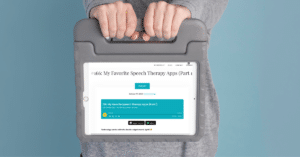Last week, we talked about evidence-based strategies for grammar drill. Now it’s time for the fun part–embedded practice! This is when we target skills in a meaningful context. For school-age students, that may mean providing intervention in the classroom or using materials from the curriculum.
Eisenberg (2007) states…
Intervention, whether in a separate room or in the classroom, should occur mostly within activities that come from the classroom curriculum, using the texts and assignments designated by the student’s teacher.
Intervention for grammatical targets should incorporate meaningful production of those targets.
She also suggests keeping a list of targets for each student and systematically working through those targets (no more than three at a time).
So, let’s take a look at what that might look like…
1. Picture Books
Many of our students are reading picture books in the classroom. If we connect with teachers, we can find out what they’re reading (or we can support in the classroom during reading activities)!
Repetitive Books: Short, repetitive books are great for readers and non-readers. The therapist can read the book with the student a few times. Once the student is familiar with the story, the therapist can leave off a word (or several words) and encourage the student to produce the target structure. We can pick books strategically basic on their targets. Stay tuned for a list of books!
Describe the Picture: After introducing a grammatical concept, we can also use the pictures in a book to practice the target. If the student struggles with auxiliary verbs, we can go through the book and tell what the characters are doing in each picture (e.g., He is eating. He is running.).
Strategic Questions: We can also ask questions about the book, strategically eliciting a target structure. Here are a few examples:
• Auxiliary Verb: What is ____ doing?
• Past Tense Verb: Where did ____ go? What did ___ do?
• Complex Sentences: Why did ____?
• Compound/Complex Sentences: How did ____?
2. Reading Passages
For older students, we can pull from their textbooks or any other text they might be using in the classroom. Here are some ideas:
Modified Mad Libs – We can teach students word classes by removing words from a reading passage. Can the students fill in the appropriate noun, verb, adjective, conjunction, etc.?
Add or Replace – Another way to work on word classes is to add or replace words and phrases in a text (e.g., adding adjectives, replacing nouns with pronouns).
Sentence Games – For students working on syntax, you can pull out sentences (maybe even cut the passage into strips!) and scaffold the creation of compound and complex sentences. Check out the grammar drill-based practice post for more ideas.
3. Student-Generated Books
I love making books in therapy! They can be used to target virtually any goal, are naturally reinforcing, and make for a perfect homework activity. They’re also easy to make. Just fold a stack of papers in half and (voila!) you have a book.
For a techier version, you can use an app like Notability to create digital books. These are easy to export and share with teachers, parents, and/or students via e-mail.
I like to pull in activities from the classroom (e.g., a story they read, the life cycle of a butterfly, a concept from a social studies lesson, etc.). We then create a book! If we’re working on past tense verbs, then we’ll tell our story in the past tense. If we’re working on plural nouns, then we’ll tell about the life cycle of two butterflies. If we’re working on complex sentences, then we’ll tell the story using those beautiful sequencing conjunctions (e.g., before, after). As you can see, it’s easy to modify the task based on the students’ needs.
This makes it easy to practice using target grammatical concepts. As an added bonus, students are often excited about sharing their books, so they are more likely to get additional practice at home. It’s also easy to include visual reminders in the book to continue scaffolding the skill as they practice outside of the therapy room or classroom.
We can also use students’ writing (i.e., classroom assignments) in therapy, but that’s an entirely different blog post. Let me know if you’re interested in learning more about this!
Okay… But what if a student isn’t getting it?
Before jumping into an embedded activity, we may want to take a few minutes to teach and drill the concept. This allows us to “prime” the student and get in some errorless practice, setting them up for success.
If the student is still struggling in context, we can use our awesome SLP powers to scaffold the skill. We are able to provide a variety of supports (e.g., visual cues, verbal prompts, models).
Let me know if you have any favorite embedded activities!
Want to read more? Check out the first post I wrote about why (and how) I teach skills in therapy. The post includes a general “framework” for teaching in therapy. You can find other posts in the series here.




Yes, please tell me more about how to use writing from the classroom in speech therapy!! I have a student who would really benefit from that, and her teacher and parent would surely love to see the progress in her writing as well.
Thanks for the feedback, Elizabeth! I’ll see what I can do!